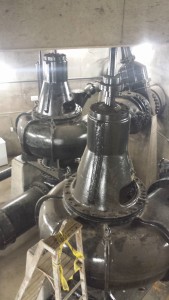WESTFIELD—According to city engineer Mark Cressotti, the Williams Riding Way Pump Station is “up and running.”
Cressotti informed the Westfield Flood Control Commission yesterday that the pump station is active. The pump station had been undergoing rehabilitation, according to Flood Control Commissioner Al Giguere, and was estimated to have cost under $2 million. Both Cressotti and Giguere said that there is still work to be done at the location, however.
“As of right now, everything is operational,” Giguere said.

All three pumps at the Williams Riding Way Pump Station. Photo taken during a July 2016 demonstration
According to Giguere, the pump station had been unofficially operational previously, but as of July 1 it became official. That was the date that the contract for rehabilitation of the site officially ended, he said. Work that still needs to be done on this phase, according to Cressotti, is the acquiring of tools and training.
The pump station was made functional in July of last year, when three pumps within the facility were renovated. The pumps were initially gas-powered and were installed in 1955, the same year as one of Westfield’s largest floods.
The equipment installed to replace the gas engines was electric-powered, with three total pumps, along with a back-up diesel generator attached in the event that electricity cannot flow to the station.
Giguere said that the pump station could be capable of pumping 60,000 gallons of water per minute, if each pump is operating.
According to an article about the site last year, Cressotti said that the pumps were last used in 2006 or 2007, prior to the rehabilitation. Also according to the article, rehabilitation at the facility started three years ago. Giguere said that the pumps have been used since the facility was made functional, but it was in order to test and evaluate the system.
Giguere said that he is hopeful that this will allow the Flood Control Commission to move onto the next phase of the rehabilitation of the pump station. This phase, according to Giguere, includes improving inflow and outflow infrastructure and rebuilding a portion of the facility called the grit chamber, which is where debris from stormwater collects.

